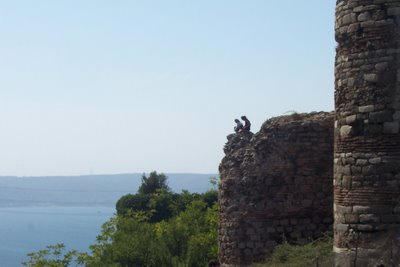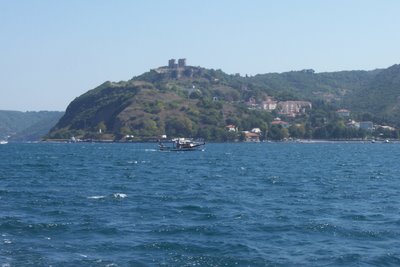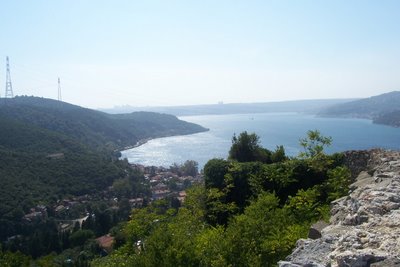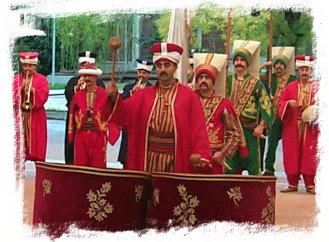




Capital city of Empires
Capital city of Byzantium and Ottoman Empire. The bridge of Asia and Europe. The city that stands on two continents. Certainly, Istanbul is the most beautiful city of the world!


The palace was being used as the house of parliament when it burned down in 1910. Today the restored Çiragan Palace is a luxury hotel.
Ciragan Cad. No:84, Besiktas
Tel: (0212) 258 33 77
Dolmabahce Palace
Dolmabahce Palace was built by Abdülmecid where formerly stood the more modest palace of Mahmud II. The Balyan family of architects finished construction on the clock tower, mosque and palace in 1853. 
The crystal hanging-lamp in the reciprocal room, which weighs 4.5 tons, was a present from Queen Victoria and is said to be the largest in the world. As Mustafa Kemal Atatürk, the founder of modern Turkey, died here on November 10, 1938, this palace holds special significance for Turks.
Besiktas
Tel: (0212) 236 90 00
Topkapi Palace
When Fatih Sultan Mehmet conquered the city in 1453 he chose to build his palace on the site of the old Byzantine palace ruins that had been looted and destroyed by the Latins. This palace was used as the Ottoman residence for almost 400 years until the reign of Abdülmecid, and was therefore subjected to many changes as it passed from sultan to sultan. After Sultan Abdülmecid moved out, the palace started falling apart like any building does after it is abandoned.

In the 19th century, the first military museum of Turkey was opened there. It serves as a concert hall because of its excellent acoustics and imposing atmosphere. Babüsselam is the main entrance of the Topkapi Palace museum. The hospital, bakery, mint and armory are in this courtyard. The kitchen buildings are situated on the right side of the courtyard. In addition to kitchen equipment, a rich 500-year collection of glass and porcelain are displayed in this building. On the left side of the courtyard stand the palace chariots where there used to be stables, the weapon collection and the entrance to the Harem. After passing through the courtyard, one comes to the Babüssaade gate which gives way to the private sections of the palace. Facing the gate is the reception room where Divan members and foreign diplomats were received. Behind the reception room are the Enderun quarters from the 18th century where now are displayed various costumes of the Sultans, and the treasury chamber, where thrones, jewels, jewel-studded weapons and medals are displayed. Also exhibited in this chamber are the most beautiful examples of the thousands of miniatures which are everywhere in the palace In the Has Room are most extraordinary examples of calligraphy. In the Hirka-i Saadet chamber, objects belonging to the Prophet Mohammed and the first caliphs of Islam are displayed. In the fourth courtyard of the palace, there are different mansions built by various Sultans, including the Bagdat, Revan, Sofa and Mecidiye residences. The Mecidiye Residence functions as a restaurant today.
After a thorough restoration during the Republican era, Topkapi Palace was turned into a museum. The towered outer entrance of the palace, the Bab-i Hümayun entrance, comes down from the time of Sultan Mehmet.
Entering from the Bab-i Hümayun, one reaches the oldest church of the Byzantine period, St. Irene. After the conquest it was used as the armory of the Janisseries soldiers.
Sultanahmet
Tel: (0212) 512 0480 - 512 0484
Yildiz Palace
The area that comes into view after crossing the Besiktas shore to the northwest used to be a forest in Byzantine times. Beginning in the era of Suleyman the Magnificent, the sultans made it their hunting grounds. In the centuries to come, it remained as a grove behind the seaside residences. The first building was constructed in this area by Sultan Selim III. The real development of Yildiz Palace begins in the second half of the 19th century under Abdülhamid II. Architects Sarkis and Agop Balyan designed the mansions named Büyük Mabeyn, Sale, Küçük Sale, Malta and Cadir.
The winter gardens and greenhouses, guardhouse, harem, Yaveran mansion, stables, theater house and exhibition building were all planned by the architect d’Aronco.
The Yildiz complex of palaces, residences and administration, security and service buildings, scattered over 500,000 square meter park area, carry the memories of many events from Turkey’s recent history.
Barbaros Bulvari Yildiz Parki, Besiktas
Tel: (0212) 258 30 80
Capital city of Empires

If you click on the map, you can see the location of Istanbul Ataturk Airport and the most important regions of Istanbul.



 The Zeyrek Mosque in Istanbul represents the largest and most significant monument in the city to survive from from the Middle Byzantine period. Built originally ca. 1118-36 by John II and Eirene Komnenos as three large, interconnected churches, the complex served as the core of the famed Pantokrator Monastery, an important site of Christian veneration, and as a imperial mausoleum, housing more than a dozen tombs of the rulers of an empire. The Pantokrator also played key role during the Latin Occupation (1204-61), as well as during Ottoman transformation of city following the conquest in 1453, when it was converted to a mosque.Although neglected in recent years, the Zeyrek Mosque retains its striking appearance: three great buildings side-by-side, topped by undulating vaults and five distinctive domes, with an irregular row of apses along its east façade, all decorated with niches and intricate brickwork. Stylistically, the building marks a critical point in the development of Byzantine architecture, as it shifts from monumentality toward complexity as the primary mode of visual expression.
The Zeyrek Mosque in Istanbul represents the largest and most significant monument in the city to survive from from the Middle Byzantine period. Built originally ca. 1118-36 by John II and Eirene Komnenos as three large, interconnected churches, the complex served as the core of the famed Pantokrator Monastery, an important site of Christian veneration, and as a imperial mausoleum, housing more than a dozen tombs of the rulers of an empire. The Pantokrator also played key role during the Latin Occupation (1204-61), as well as during Ottoman transformation of city following the conquest in 1453, when it was converted to a mosque.Although neglected in recent years, the Zeyrek Mosque retains its striking appearance: three great buildings side-by-side, topped by undulating vaults and five distinctive domes, with an irregular row of apses along its east façade, all decorated with niches and intricate brickwork. Stylistically, the building marks a critical point in the development of Byzantine architecture, as it shifts from monumentality toward complexity as the primary mode of visual expression.